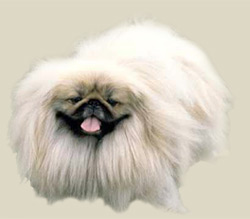
Country of Origin: China
Group: Companion and Toy Dogs
Section: Japan Chin and Pekingese
Original Function: lap dog
Todays Function: companion
Dimension Male: 30-45 cm
Dimension Female: 30-45 cm
Weight Male: 3,6-4,5 kg
Weight Female: 3,6-4,5 kg
Litter Size: 2-4 puppies
Life span: 13-15 years
Other Names: Lion Dog, Peking Palasthund, Peke
Colors: All coat colors are acceptable and of equal merit.
Living: Although the peke has a thick coat and can tolerate the cold, they do better as an indoor dog. they
Recognized: FCI, AKC, UKC, KCGB, CKC, ANKC, NKC, NZKC, PCA, APRI, ACR
Description
The Pekingese has an extravagant, long, straight-flowing coat that has profuse feathering and comes in all colors. It has a broad head that is wide between their large, dark, lucid and slightly prominent eyes. The face is flat with a dark, wrinkled muzzle, and drooping heart-shaped, long feathering ears. Their necks are short and thick. When their mouth is closed, neither teeth nor tongue should show. These tiny, heavy boned dogs have a characteristic rolling gait.
Temperament
The Pekingese is decidedly not a sissy lap dog. It is a courageous character that will not start a fight but will not back down from one either. It tends to be aloof around strangers. It is extremely devoted to its family, but it is independent and not overly demonstrative. Its stubbornness is legendary. Although playful around family members, it may not be athletic or playful enough to satisfy many children.
Excercise
The Pekingese enjoys a leisurely walk outdoors, but it is equally happy to romp inside. It can easily die of heat prostration. It must be kept in air conditioning in warm weather. It can spend time outside in cool weather, but it should sleep inside. It is an ideal apartment dog. The coat will mat unless combed at the very least weekly, preferably more often. The over-nose wrinkle should be cleaned daily to avoid infection. The coat around the anus must be inspected daily for soiling. Pekingese tend to snore!
Grooming
Daily combing and brushing of the very long, double coat is essential. Take extra care around the hindquarters, which can become solid and matted. Females shed the undercoat when in season. Dry shampoo regularly. Clean the face and eyes daily and check th
Health
Major concerns: none
Minor concerns: elongated soft palate, stenotic nares, KCS, patellar luxation, disticiasis, trichiasis, skin fold dermatitis
Occasionally seen: urolithiasis
Suggested tests: knee, (eye)
Note: The breed is sensitive to anesthesia.

